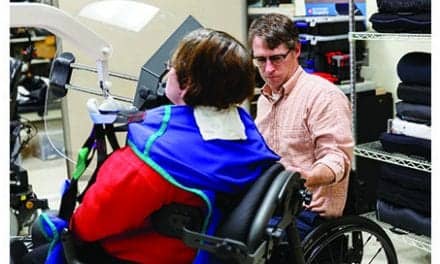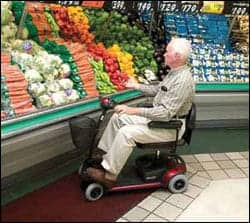 |
Foam, gel, air, and more: To find the best wheelchair cushion for your client’s seating and positioning needs, know the benefits, limitations, and costs.
There are numerous wheelchair cushions on the market, and the choices may seem overwhelming to both clients and assistive technology practitioners (ATPs). It is therefore extremely important to determine the goals of the equipment as it relates to each individual client. There are both inherent client needs as well as specific product design features that must be matched to create successful seating solutions.
Completion of a thorough seating and mobility assessment is the key to identifying clients’ specific seating needs. Based on the assessment, specific cushion features can then be determined.
Top Five Issues for Seated Positioning:
- Positioning;
- Balance;
- Pressure management;
- Function; and
- Comfort.
Client position is integral to both comfort and function. The purpose of the seat cushion is to provide a stable base of support to offer both safety to skeletal and muscular structures, and stability from which movement of trunk and limbs can originate. Ideally, this level base of support should promote postural alignment.
Where possible, the cushion is used to promote a level pelvis (correcting flexible pelvic obliquity) reducing unbalanced muscle forces contributing to scoliosis. The cushion should support the pelvis in a neutral position (decreasing posterior/anterior tilt) to reduce development of kyphotic or lordotic spinal postures. This correction is possible only where flexibility exists. If the client presents with fixed asymmetries/deformities, the cushion will have to accommodate the client’s position but offer orientation to allow the best access to functional activities.
“Dynamic stability” is an important goal of the cushion. Although the seating system provides a static position for the pelvis and lower extremities, it also provides the basis for movement. Stability and support at the pelvis and lower trunk will allow freedom of movement in the upper trunk and extremities, and permit maximal energy to be translated into movement rather than in stabilizing the body. For clients to function within their wheelchair, they must have freedom to access daily activities, propulsion, joystick access, and transfers. Movements must be considered when looking at client position to allow for maximal strength, range of motion, and the protection of joints from overuse injuries.
Cushion support is also necessary to promote a client’s balance in the wheelchair. Orientation of the cushion within the wheelchair frame, contour of the cushion, and cushion materials are important factors in providing stability. Ideally, the cushion should “grip” the pelvis, reducing forward sliding and shear forces. The client will then experience greater comfort and safety within the wheelchair system.
The cushion surface must also assist in reducing the risk of tissue trauma. In the sitting position, the pelvis becomes the primary weight-bearing structure. There are many bony prominences on the surface of the pelvis; thus, there is an inherent risk of skin breakdown. Skin breakdown increases as clients display additional risk factors such as:
- muscle atrophy;
- lack of independent movement (weight shifting);
- heat and moisture buildup (incontinence);
- lack of sensation (reducing “cues” for position change, reduced circulation);
- repetitive movements causing shear forces; and
- poor nutrition.
Traditionally, the goal of seating products has been to reduce pressure by increasing surface area. Even pressure distribution contributes to circulation and positioning as long as the forces are not significantly higher in a small surface area. Immersion of the bony structures into a viscous material assists in distributing forces over a greater surface area. Contouring of the cushion surface allows for increased weight distribution over larger weight-bearing areas such as the thighs and gluteal surfaces. This reduces the pressure over bony pelvic structures (ischial tuberosities, coccyx, and greater trochanters).
New technologies are reintroducing the concept of “offloading”—translating pressure to muscular areas such as gluteal and posterior thigh areas, and eliminating pressure from ischial tuberosities and coccyx. This reduces the risk of skin breakdown and promotes healing where breakdown has occurred. This concept must be used with caution to ensure that pressure is still evenly distributed over these muscular structures so as not to develop areas of high pressure elsewhere. Client comfort is still of utmost importance. Subjective comfort is essential in ensuring that clients use the products prescribed and are able to maintain daily routines without additional pain and fatigue from the cushion.
WHICH CUSHION IS BEST?
Many cushions have been developed over the years combining different shapes and materials. This is indicated by the fact that our clients are all individuals with unique shapes and seated postures. Which cushion is best can be determined only by identifying and prioritizing clients’ postural and skin-management needs.
Eight Cushion Factors:
- Weight of cushion;
- Height of cushion;
- Contour/shape;
- Stability versus immersion;
- Cushion materials;
- Cover material;
- Maintenance; and
- Cost.
Interface with the wheelchair is important in determining cushion size. Height will affect transfers and environmental access. Depth will affect chair balance, positioning of lower extremities on the footrests, and possible access to removal of footrests. Weight is important when considering client maneuverability and propulsion, portability, and caregiver lifting and pushing.
Contour and shape should match the client as closely as possible to reduce excessive pressure buildup on bony prominences and areas at risk for skin breakdown. Pressure mapping can assist in the determination of contour matching. Custom cushions may be considered if the client displays asymmetries, deformities, sliding, postural instability, or skin breakdown. It is also important to consider heat and moisture buildup as a potential risk when prescribing a highly contoured cushion.
Foam cushions have been developed over the years because foam can be easily carved and molded to create contours. With the development of viscoelastic foams, immersion of bony prominences is attainable to increase surface area. Layered foams of different densities are essential for the cushion to maintain its shape.
Foam cushions are popular because no maintenance is required, the material is light, and cost is not exorbitant. Foams are temperature sensitive, so cushions should not be left in areas of extreme cold. New foams with breathable properties are now being used to allow for custom-contoured cushions without the heat buildup. Use of material technologies from outside industries is now providing the seating industry with alternatives, although cost may be a significant factor.
Polymer gels provide shear reduction as the material moves with the skin, but due to the density it does not allow for much immersion. The material is not temperature sensitive and tends to assist in cooling the skin. These gels are heavy and are often used in conjunction with a foam-based cushion.
Fluid gels promote immersion and shear reduction because they allow bony prominences to move within the fluid. Constant movements within the cushion may cause the fluid to redistribute, allowing for “bottoming out” and increased risk of pressure points. As with the polymer gels, fluid cushions are heavy.
Air provides the perfect medium for immersion. The limitation is containing the air for stability. A variety of air cushions have combined the positive use of flotation technology while limiting instability of the surface by containing air in quadrants and pockets. Air also helps to reduce buildup of heat and moisture. Air cushions are light but require maintenance because the air must be maintained to allow for proper immersion.
Although cushion materials are important, cover materials are equally essential to allow immersion of the body into the contour of the cushion. Significant interface pressures have been identified when nonstretchy materials are used over contoured cushion surfaces. It is therefore essential that multiple stretch fabrics be used.
COST CONSCIOUS
Cost is a significant factor in equipment selection, so the ideal parameters of the system should be identified and prioritized. Lower-priority items can be deleted from the system to save money, if necessary. Providers and manufacturers must educate clients and caregivers on the benefits of positioning, maintenance, and the effect of cushion choice on function. The client ultimately makes the final decision based on comfort, function, aesthetics, and cost.
The author acknowledges and thanks T. Hetzel and J. Padgitt for insights gained at their 2005 21st International Seating Symposium presentation on “Seating, The Next Generation.” The author also thanks B. Mogul-Rotman for his presentation, “I’m Not Comfortable, Fix It!” at the 2005 Canadian Seating & Mobility Conference.
Kathryn Fisher, OT, ATS, is education manager at Shopper’s Home Health Care, Toronto, Ontario, Canada. She can be reached via e-mail at .





